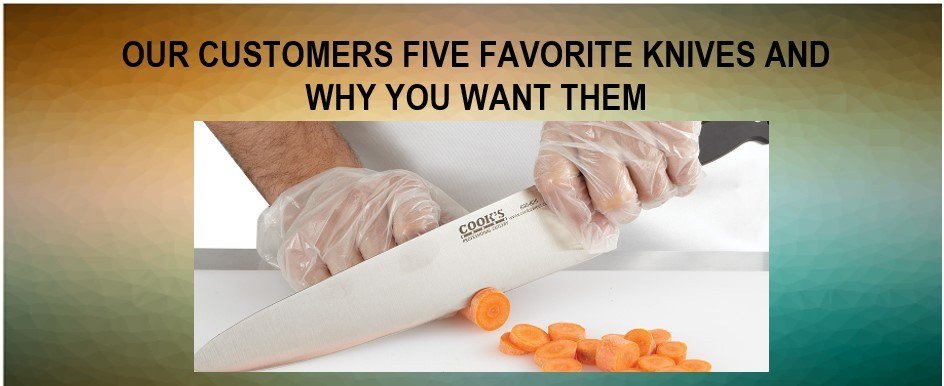There are so many different knives available, it’s hard to know which ones belong in your professional cutlery inventory. There are the obvious choices like a Chef’s knife, but we wanted to hear from our customers which professional knives were their favorites and why.
Chef Dan, District Chef, K-12, VA – I find a quality paring knife to be a vital, small but powerful tool. With my paring knife in hand, I can segment lemons precisely and slice stems off small vegetables or delicate fruits like a strawberry. A paring knife is the perfect tool for deveining seafood. Look for a paring knife that is lightweight, with a razor sharp blade that’s between 2-1/2” to 4”. If you do a wide variety of tasks in your kitchen that require a paring knife, you may consider getting one shorter blade knife that’s under 3-1/2” and then a second professional paring knife with a longer blade. I would also recommend a bird’s beak knife if you’re making more precision cuts. With its narrow tip, a bird’s beak paring knife can make near-surgical incisions, turning tightly to cut out a stem and leaving more of the fruit intact.
Chef Joan, Executive Chef, Private College, WA - My personal favorite is my santoku knife. While most chefs are familiar, the santoku is a style of knife that originated in Japan, with a shorter blade and rounded front edge. The name means “three virtues,” which are the three main uses of the santoku knife: slicing, cutting, and chopping. It is my preferred alternative to my usual 8-inch chef’s knife. The shape of the blade gives me excellent precision and control for tasks like mincing garlic, chopping vegetables, or slicing raw meats and fish. Another unique trait of the santoku knife is the Granton edge. If you’re not familiar with the term, this is when the blade looks scalloped, featuring indentations on the face of the blade. The purpose of these indentations is to introduce air into the cut, in turn reducing friction so that food releases easily while slicing so that you don’t have to stop and remove sticky ingredients between each cut. My santoku is also my go to knife when I have a recipe that calls for minced herbs; like garlic or parsley, as it is ideal for making very fine cuts and doesn’t tear delicate herbs preserving the flavor. And when I’m finished mincing, I am easily able to scoop up my ingredients using the wide blade.
Henry, Head Chef, Corporate Dining, CO – My “must-have” professional knife is the serrated utility knife. From slicing tomatoes to baguettes, hard salami, and avocados, this is my go-to cutlery choice because of its versatility. It’s perfect for cutting a prepared BLT to slicing the top off a pineapple. The serrated utility knife is used for slicing bread, meats, or other foods with a hard crust or tougher outer skin like watermelon. This knife is also great for cutting soft or juicy vegetables like tomatoes. You may also be surprised to know that a longer serrated utility knife is ideal for getting a cake perfectly flat because it can easily cut through a 9” round cake in a single pass.
Chef Jamie, Sous Chef, LA - Just as the name implies, a boning knife is the knife to use when boning fresh fish, meat, or poultry. These knives are thin, sharp, and flexible with a curved blade that measures 5 to 7 inches long. You can’t use other knives as they are made to cut in straight lines. When I am working with joints and ribcages, that straight line goes out the window; this type of work requires a blade that will flex and move. With its sharp point and narrow blade, a boning knife gives you the latitude you need to cut around the bones, and a good boning knife will have the give or flex required to neatly separate meat from bone, remove skin and easily cut through joints and cartilage.
Chef Janine, Chef Instructor, Community College Culinary Arts Program, IL - On my list of favorite knives is the sharpening steel or honing rod. While this isn’t a knife, per se, it is on my list of must-have professional cutlery tools and essential to have in the institutional kitchen. After all, the best knife in the world isn’t much good without a sharp edge. The name sharpening steel is a bit misleading because it doesn’t sharpen a blade so much as it smooths the edge. As you use a knife, microscopic pieces or fibers of the blade get bent to either side causing resistance, and over time it becomes more difficult to push the blade through food. When you run the knife along a sharpening steel, this realigns or hones the edge which gives you cleaner and easier cuts. Keep in mind that a sharpening steel should only be used with a straight-sided blade like a chef’s knife, santoku, paring knife or boning knife. You can’t use it with a serrated knife as the teeth won’t glide along the steel and there won’t be any benefit from the process.
You can find all the professional knives listed above at Cook’s Direct and many others, including slicing knives, cleavers, bread knives and more. If you need any assistance in selecting the right professional knives for your foodservice kitchen, give us a call at 866.613.2617 or send an email to customerservice@cooksdirect.com and we’ll be happy to assist you.
